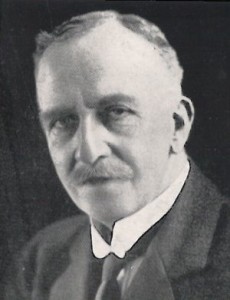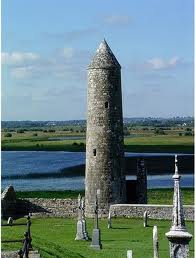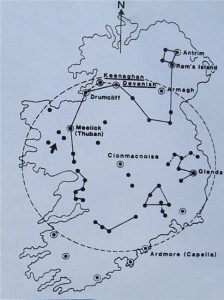Royal Irish Academy
Scharff, R. F.
Robert Francis Scharff (1856-1934) was born in Britain of German parents. He is best known as the director of the Natural History Museum in Dublin at the beginning of the 20th century. 
He was of the opinion that there had been a land bridge between Europe and America, which had also been home to Atlantis. Dr Scharff addressed the Royal Irish Academy on at least two occasions[539][540] on this subject. However, in 1899 he published The History of the European Fauna[1027] in which he made an even earlier reference to “the old landbridge between Europe and North America, which is generally known by the name of Atlantis.”(p.49)
>In a short paper(a) titled Some Remarks on the Atlantis Problem, delivered to the British Association in Belfast in 1902, Scharff reported “The results of my investigations tend to show that Madeira and the Azores are the remains of an ancient tertiary area of land which was joined to Europe, and that it probably became disconnected in Miocene times. Since then this land once more became united with our Continent, and may not have been finally severed until the Pleistocene period. As regards the question of a landbridge across the Atlantic, many reasons can be given in favour of such a theory. It must, however, have occupied a position farther south than the land just alluded to.” Although the idea of trans-Atlantic landbridges soon lost favour, the Azores and Madeira are still advocated by some as the remnants of Atlantis.<
Scharff among others of his day was strongly opposed to the idea that extensive ice sheets had covered huge areas of Europe and North America during the last Ice Age.
In a later book, Distribution and Origin of Life in America [1159]+, he offered further faunal evidence in support of an Atlantean landbridge in the Atlantic and quotes Professor Heinrich Simroth (1851-1917), who posited a landbridge from Portugal to the West Indies (p.213).
In 1926, Lewis Spence wrote[259.56] of Scharff as having “contributed more valuable data to the literature of Atlantean research than any other living scientist.”
Theodor Arldt (1878-1960), a German geographer, expressed similar views in 1907 regarding an Atlantic land bridge but placed it in the Miocene Epoch millions of years ago.
[1027]+ http://www.forgottenbooks.com/readbook/The_History_of_the_European_Fauna_1000205601#3
[1159]+ http://www.forgottenbooks.com/readbook/Distribution_and_Origin_of_Life_in_America_1000137980
(a) [PDF] V.—Some Remarks on the Atlantis Problem. | Semantic Scholar *
O’Brien, Henry
Henry O’Brien (1807-1835) was an Irishman born in Co. Kerry who only lived a short twenty-eight years. In 1830 the Royal Irish Academy  sponsored a competition for the most appropriate essay, which explained the origin and purpose of Ireland’s Round Towers. The winner’s prize went to George Petrie. O’Brien’s thesis was considered too radical and so, controversially, O’Brien was only awarded a consolation prize of £20.
sponsored a competition for the most appropriate essay, which explained the origin and purpose of Ireland’s Round Towers. The winner’s prize went to George Petrie. O’Brien’s thesis was considered too radical and so, controversially, O’Brien was only awarded a consolation prize of £20.
His work was published in 1834[124] and republished in more recent years with new but totally misleading titles that imply that the author linked Ireland with Atlantis[125][126]. The book has nothing to do with Atlantis or Plato but is an attempt to attribute the building of the famous round towers of Ireland to the Tuatha dé Danann who invaded Ireland in the distant mists of time and whom O’Brien contended came originally from Persia. The book is written in the turgid style of the period and today would not be considered an ‘easy read’. However, his book can now be read or downloaded from the internet for free(a).
While O’Brien’s theory may appear outlandish today, the 21st century has continued to generate revolutionary  theories regarding our round towers, relating to both their function and location. American professor Phil Callahan, after studying a map of Ireland showing the towers he realised that “the towers formed a star map of the northern night sky at the time of the winter solstice.” However he goes further(b)(c), claiming that “Soils around round towers are highly paramagnetic and enjoy great fertility.”
theories regarding our round towers, relating to both their function and location. American professor Phil Callahan, after studying a map of Ireland showing the towers he realised that “the towers formed a star map of the northern night sky at the time of the winter solstice.” However he goes further(b)(c), claiming that “Soils around round towers are highly paramagnetic and enjoy great fertility.”
Callahan believes that the Irish towers act as wave-guides or aerials for extra-low-frequency (ELF) radiation from high above Earth ( Schumann radiation) and the sun . Vital to our health, ELF waves are able to penetrate water and soil, unlike higher frequencies of radiation. To amplify incoming ELF, towers must be paramagnetic, and the effect is enhanced even more when paramagnetic and diamagnetic (i.e. weakly repelled by a magnet) materials are sandwiched together. Callahan’s theories are more fully explored in his Ancient Mysteries, Modern Vision[1528].
(a) https://www.gutenberg.org/ebooks/42538
(b) https://frackingfreeireland.org/2015/01/06/the-irish-round-towers/ (link broken May 2018)
>(c) Philip Callahan and The Round Towers | MalagaBay (archive.org)<
